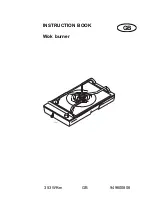
37
20140894
GB
Maintenance
8.1
Notes on safety for the maintenance
The periodic maintenance is essential for the good operation,
safety, yield and duration of the burner.
It allows you to reduce consumption and polluting emissions and
to keep the product in a reliable state over time.
Before carrying out any maintenance, cleaning or checking oper-
ations:
8.2
Maintenance programme
8.2.1
Maintenance frequency
The combustion system should be checked at least once a
year by a representative of the manufacturer or another spe-
cialised technician.
8.2.2
Checking and cleaning
Combustion
The optimum calibration of the burner requires an analysis of the
flue gases. Significant differences with respect to the previous
measurements indicate the points where more care should be
exercised during maintenance.
Pump
The pressure
must be stable and at the same level as measured
during the previous check (between 10 and 14 bar).
The depression
must be less than 0.45 bar. Values different
from those measured previously may be due to a different level
of fuel in the tank.
Unusual noise
must not be evident during pump operation.
If the pressure is found to be unstable or if the pump runs noisily,
the flexible hose must be detached from the line filter and the fuel
must be sucked from a tank located near the burner. This meas-
ure permits the cause of the anomaly to be traced to either the
suction piping or the pump.
If the pump is found to be responsible, check to make sure that
the filter is not dirty. The vacuum meter is installed upstream from
the filter and consequently will not indicate whether the filter is
clogged or not.
Contrarily, if the problem lies in the suction line, check to make
sure that the filter is clean and that air is not entering the piping.
Filters (Fig. 38)
Check the following filter boxes:
• on line 1) • in the pump 2) • at the nozzle 3), and clean or replace
as required.
If rust or other impurities are observed inside the pump, use a
separate pump to lift any water and other impurities that may
have deposited on the bottom of the tank. Then clean the insides
of the pump and the cover sealing surface.
Fan
Check to make sure that no dust has accumulated inside the fan
or on its blades, as this condition will cause a reduction in the air
flow rate and provoke polluting combustion.
Combustion Head
Check to make sure that all the parts of the combustion head are
in good condition, positioned correctly, free of all impurities, and
that no deformation has been caused by operation at high tem-
peratures, especially in the following areas:
•
The electrode tips, see (Fig. 14 on page 19)
•
The electrode insulators
•
The high-voltage cable
•
The nozzles and the flame stability disk
•
The blast tube, especially at its end
•
The boiler plate/burner gasket
•
The boiler door fettling
8
Maintenance
DANGER
The maintenance interventions and the calibration
of the burner must only be carried out by qualified,
authorised personnel, in accordance with the con-
tents of this manual and in compliance with the
standards and regulations of current laws.
DANGER
Disconnect the electrical supply from the burner
by means of the main system switch.
DANGER
Close the fuel interception tap.
D384
Fig. 38
Summary of Contents for PRESS 1G
Page 2: ......










































